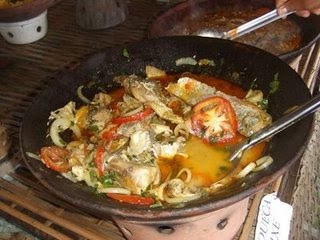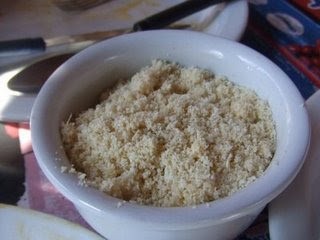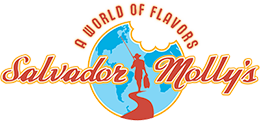Moqueca de Camarao in Salvador, Brazil
Sam Sadle updates us from Salvador, Brazil.
After traveling through five countries, we finally arrived at long last in Brazil; a country in the middle of South America, vast in size and population, with a somewhat bizarre language, and a racial makeup more diverse than the United States. Brazil is in many ways very disconnected from the rest of the continent, but this discord was most apparent when it came to food. Although some of the border regions of Brazil overlap with the culinary traditions from neighboring states (for instance, Argentine style BBQ in Rio Grande do Sul), in parts of the country removed from international borders, culinary traditions tended to be much further removed from not only the rest of South America but from what we think of as traditional western cooking.
After spending a couple of days in the Gaucho dominated cooking of southern Brazil, we boarded a plane and headed to Salvador de Bahia, a central Brazilian coastal city known as “Africa-in-exile .” Bahia has a cooking style all its own. Take a cup of mainstream Brazilian traditions, combine with two heaping cups slave cooking brought from Africa, let stew, and add a large helping of Bahian pig-headedness and independence and you’ve got the makings of a unique culinary tradition and an amazing locale. I found Bahian food to be unlike anything else I’ve experienced in South America or for that matter anywhere else. It is full of taste, texture and oh so much amazing color. Although there will be many entries on Bahian food in the near future, I want to start with the dish that in many ways defines the region, Moqueca is a redish-orange fish stew usually served with shrimp (thus titled Moqueca de Camarao).
.” Bahia has a cooking style all its own. Take a cup of mainstream Brazilian traditions, combine with two heaping cups slave cooking brought from Africa, let stew, and add a large helping of Bahian pig-headedness and independence and you’ve got the makings of a unique culinary tradition and an amazing locale. I found Bahian food to be unlike anything else I’ve experienced in South America or for that matter anywhere else. It is full of taste, texture and oh so much amazing color. Although there will be many entries on Bahian food in the near future, I want to start with the dish that in many ways defines the region, Moqueca is a redish-orange fish stew usually served with shrimp (thus titled Moqueca de Camarao).
Moqueca is a Bahian event, taking hours to prepare so each ingredient comes harmoniously together to create a phenomenal end of the day meal. Moqueca tastes unlike anything I had ever tried before; at first taste it is a coconut broth base with peppers and something that appears to be saffron, but simultaneously it is not. The slow steaming of the fish and shrimp in the coconut makes for succulently rich meat, which are nicely balanced by the acidic peppers and tomatoes as well as the sweet stewed onions. Moqueca is almost always served with rice, copious amounts of inexpensive Brazilian beer, dende oil, vatapa (a fish paste) and manioc flour (more on those later). The picture details a basic moqueca de camarao that Lisa and I discovered at a basic Bahian buffet.
Moqueca is normally served with two uniquely side dishes that each add a new element to this stew. Manioc flour is the ground remains of the cassava or manoic root. By itself, the flour does not enhance the flavors of this already robust dish, but it acts a thickener, transforming the watery texture of the coconut into a stiff paste.
The second side dish always served with a good moqueca is vatapa, a fish mash of a dozen or so ingredients that added an entirely new flavor profile to the already complicated moqueca. To be honest, Lisa and I found the vatapa to be interesting in both texture (slightly grainy) and flavor profile (completely unrecognizable), but did not seem to add much to the moqueca. Due to our inexperienced palates, we tended to avoid both the manoic flour and vatapa. All in all, Moqueca is a great representation of the unique flavor and texture mixtures that are Bahian cooking, but most of all, it’s a really tasty and uniquely Bahian dish. Good luck to those who attempt these recipes below.
Moqueca de Camarao
Juice of 1 lemon
1 onion, finely chopped
1 clove garlic, minced
1 to 2 tablespoons white vinegar
1/2 teaspoon salt
1 pound fresh shrimp, shelled and deveined
1 teaspoon fresh cilantro, chopped
2 tablespoons tomato paste
Black pepper to taste
1 cup thin coconut milk*
1/2 cup thick coconut milk*
2 to 3 tablespoons dende oil**
Make a marinade with lemon, onion, garlic, vinegar and salt. Marinate the shrimp for 30 minutes. Put mixture into a sauce pan and add cilantro, tomato paste and black pepper to taste. Add thin coconut milk and cook over low heat until the shrimp are cooked. Add the thick coconut milk and dende oil. Continue cooking for another 5 minutes. Serve with rice.
Vatapa Recipe
Onion, chopped — 2
Dried shrimp (see notes) — 1/2 cup
Garlic, chopped — 2-3 cloves
Malagueta or jalapeño chile peppers, chopped — 1-4
Oil — 3 tablespoons
Stock or water — 1 1/2 cups
Natural peanut or cashew butter — 1/2 cup
Breadcrumbs — 1 cup
Salt and pepper — to taste
Shrimp, peeled and deveined — 1 pound
Coconut milk — 2 cups
Dendê oil (optional) — 1/4 cup
Place the onion, dried shrimp, garlic and chilies in a food processor or blender and puree well. Add a little water if necessary. Heat the oil in a large saucepan over medium heat. Add the onion-shrimp mixture and sauté until cooked through, about 5-7 minutes. Stir in the stock or water and whisk in the peanut or cashew butter until smooth. Then stir in the breadcrumbs, salt and pepper. Bring to a boil, then reduce heat to medium-low and simmer for 5-8 minutes to meld the flavors. Stir in the shrimp and coconut milk and simmer another 5-6 minutes, or until shrimp is almost cooked through. Remove from heat, stir in the dendê oil and serve.
The original recipe can be found here.
